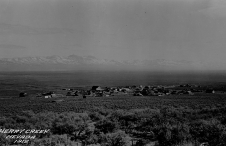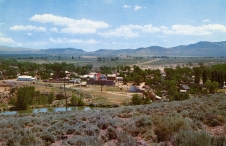Aurora
In 1860, the discovery of gold and silver about eighty miles southeast of Virginia City led to the creation of the boomtown Aurora. E. R. Hicks, J. M. Corey, and James Braley made the find while on a hunting and prospecting expedition. On August 30, 1860, they established the Esmeralda Mining District. A town site quickly emerged, and was later named Aurora after the Roman goddess of the dawn. During its short life, Aurora produced $16 million in bullion, was the subject of a major boundary dispute, and was the execution site of one of Nevada's more notorious gunfighters.
Hundreds of prospectors poured into the area after the discovery, and within two weeks, 357 claims were established. Winter did not deter the progress of the town site, and by February 1861, Aurora supported a quartz mill along with 150 tents and other structures. Samuel Clemens, who would later become known as Mark Twain, arrived in Aurora in 1862, but spent only four months there before leaving for Virginia City. The town continued to grow after Clemens departed, and reached its peak in the summer of 1863 with two daily newspapers, two stage lines, seventeen quartz mills, a telegraph, and almost 800 houses or cabins. But the ore bodies in the area turned out to be shallow at only one hundred feet, and in 1864, the town began a decline that never stopped. By 1870, the population had fallen to 160.
Civil disturbances were common in many nineteenth-century mining camps, but they were often the result of property disputes, claim jumping, or were targeted toward social or ethnic groups. This was not the case in Aurora. The town was a case study in lawlessness, but it generally occurred between gunfighter and gunfighter, and two unique factors contributed to the tension that inevitably led to violence.
At first, it was not known whether Aurora lay in California or Utah Territory. The ambiguity caused restlessness as early as 1860, when miners actively petitioned the California legislature to form a new county, thus protecting the town from unpopular laws in Utah. California accommodated the townspeople by forming Mono County in 1861, with Aurora as its seat. Later that year, the Nevada Territory was formed, and Esmeralda County was established with Aurora as its seat. The town was now the control center of two counties, in two different states. Political tension remained high until September 1863, when a formal survey determined that Aurora was in Nevada by over three miles.
Next, Aurora's boom years between 1861 and 1865 coincided exactly with those of the American Civil War, and feelings about the conflict were intertwined with the boundary dispute. Republicans, who sided with the Union, anxiously hoped that Aurora would be found to be in Nevada. Democrats, who sided with the South, often clashed with Republicans. Verbal fights between the two sides sometimes turned violent, and in 1862, a unionist and editor of the Esmeralda Star was shot in the leg by a secessionist.
Newspaper reports and historical records indicate that as many as thirty-one men were murdered in Aurora during its boom years. Most were deemed justifiable acts of self-defense. An exception occurred in 1864, when notorious gunfighter John Daly and his gang murdered way-station operator William Johnson. Daly was avenging the killing of his friend, James Sears, who had been killed by one of Johnson's employees for horse stealing. Johnson was well-liked in the community, and townspeople quickly organized the "Citizens' Safety Committee" after learning of the murder. Rather than try the men in court, the committee declared martial law in Aurora, and sentenced Daly and three of his men to death. Gallows were erected, and on February 9, 1864, the vigilantes administered the sentence.
A small amount of mining activity continued in Aurora into the 1870s, with some speculators holding out hope that running deep shafts would again find ore. Those efforts would prove futile, and in 1883, Aurora lost its status to Hawthorne as Esmeralda's county seat.
But Aurora was not dead yet. The rich ore discoveries in Tonopah and Goldfield inspired J. S. Cain to begin working the claims again in 1905. Miners and businessmen began returning to Aurora, and by 1906, the post office reopened. Another town called Mangum was established nearby to accommodate workers. The operation changed hands several times before coming under the control of Aurora Consolidated Mines, which recovered $1,850,000 from the mines and tailings. The company closed with the advent of World War I, when labor became scarce.
Today, there is little left of Aurora. All the wooden structures were either removed, reused, or have succumbed to the elements. During the post-World War II building boom, Aurora's brick buildings were dismantled for use in home construction in California and Nevada. A few headstones and building foundations are all that is left of the town.
Article Locations
Related Articles
Further Reading
None at this time.



